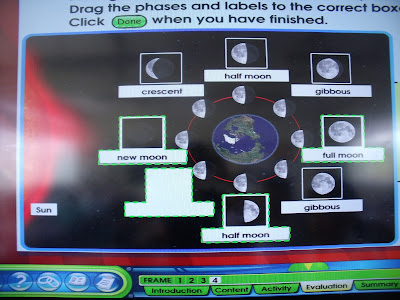Wednesday, 31 October 2012
Tuesday, 30 October 2012
Monday, 29 October 2012
Saturday, 27 October 2012
The 8 phases of the Moon
Phase 1 - New Moon - The side of the moon that is facing the Earth is not lit up by the sun. At this time the moon is not visible.
Phase 2 - Waxing Crescent - A small part (less than 1/2) of the moon is lit up at this point. The part that is lit up is slowly getting bigger.
Phase 3 - First Quarter - One half of the moon is lit up by the sun at this point. The part that is lit up is slowly getting bigger.
Phase 4 - Waxing Gibbous - At this time half of the moon is lit up. The part that is lit is slowly getting bigger. Waxing means to slowly get bigger.
Phase 5 - Full Moon - The side of the moon that is lit up by the sun is facing the Earth. The entire moon is lit up at this point.
Phase 6 - Waning Gibbous - The moon is not quite lit up all the way by sunlight. The part of the moon this is lit is slowly getting smaller. Waning means to slowly get smaller.
Phase 7 - Last Quarter - Half of the moon is lit up but the sun. The part that we can see lit up is slowly getting smaller.
Phase 8 - Waning Crescent - A small part of the moon is lit up at this point. It is getting smaller by the minute.
Thursday, 25 October 2012
Tuesday, 23 October 2012
Further Activity
1. Use 28 pieces of
paper of the same size.
2. Draw a circle of
the centre of each paper. The circles must be of the same diameter.
3. Number the papers
1 to 28.
4. Colour the circle
on paper number 1 according to the shape of the Moon that you
observed on day 1
(refer to the “Lunar Calendar Chart”).
5. Repeat step 4 for
all papers.
6. Arrange and then
staple on the right side of the papers according to the date of the
lunar calendar.
7. Flip the pages as
fast as you can until you see the changes of the phases of the Moon.
Monday, 22 October 2012
It is just a phase
What do I want?
To observe the phases of the Moon.
What do I need?
 |
| Cardboard |
 |
| String |
 |
| Glue |
 | ||||||
| Marker pen |
 |
| Ruler |
 |
| Scissors |
What do I do?
1. Cut a circular
cardboard 30 cm in diameter.
2. Fold the circular cardboard into four equal segments. Then, divide each
segment into seven and unfold it. Number them from 1 to 28
counterclockwise. This is
your “Day of Observation Chart”.
3. Make a small hole on the top of the chart. Tie a string and hang the chart.
4. Observe the shape of the Moon and draw it on the segment of the “Day of
Observation Chart”.
5. Repeat your
observation every night for 28 nights and record your
observation on the segment according to the day of observation.
6. Cut a circular
cardboard 10 cm in diameter to form a “Lunar Calendar
Chart”.
7. Repeat step 2.
8. Paste the “Lunar
Calendar Chart” on the “Day of Observation Chart” so
that segment number 15 on the “Lunar Calendar Chart” corresponds to full
moon on the
“Day of Observation Chart”.
9. The numbers on the smaller card represent the lunar calendar.
10. From the “Lunar Calendar Chart” identify new moon,
crescent moon,
half-moon and full moon.
What do I find?
1. On what day of the
lunar calendar can you see full moon?
2. On what days of
the lunar calendar can you see half-moon?
3. What is the
difference between the first crescent moon and the second crescent
moon?
What do I conclude?
There are (four / eight) major phases of the Moon in one
month of the lunar calendar.
Sunday, 21 October 2012
Phases of the Moon
What is the phase of the moon?
The changing shape of the bright part of the Moon that we see is called its phase.
What causes part of the Moon to be lit up?
The moon is illuminated because it reflects the light from the sun. The part of the moon facing the sun is lit up. The part facing away from the sun is in darkness.
What causes the different phases of the Moon?
The phases of the Moon depend on its position in relation to the Sun and Earth. As the Moon makes its way around the Earth, we see the bright parts of the Moon's surface at different angles. These are called "phases" of the Moon.
What are the different phases of the Moon called?
The phases of the moon work in a cycle starting with the new moon.
There are eight
phases of the moon
The phases are named after how much of the moon we can
see, and whether the amount visible is increasing, or decreasing each day.
It takes our Moon about 29.5
days to completely cycle through all
eight phases. This is known as a Lunar month
The Phases of
the Moon
As the moon circles the
Earth, the shape of the moon appears to change; this is because different
amounts of the illuminated part of the moon are facing us. The shape varies
from a full moon (when the Earth is between the sun and the moon) to a new moon
(when the moon is between the sun and the Earth).
Friday, 19 October 2012
Subscribe to:
Posts (Atom)





























